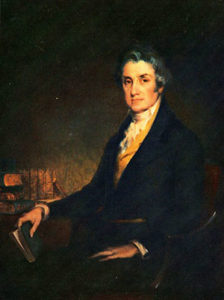If our newly formed nation had to pick a Founding Father to transform higher education across America — and create a critical pillar of our fledgling democracy — Abraham Baldwin would have been an unlikely choice.
The son of a Connecticut blacksmith, Baldwin was only 30 years old when he crafted one of the most groundbreaking documents in our nation’s early history — the charter that established the University of Georgia as the birthplace of public higher education in America.
“Our present happiness joined to pleasing prospects should conspire to make us feel ourselves under the strongest obligation to form the youth, the rising hope of our Land,” Baldwin wrote in the charter, which was adopted 232 years ago by the Georgia General Assembly on Jan. 27, 1785.
“Think about it — they couldn’t even pay off their Revolutionary War debts, but they were looking for ways to provide public education for our students,” said Sylvia M. Hutchinson, a professor emerita of reading education and higher education who serves as a senior adviser in the UGA Division of Academic Enhancement. “These people were far-reaching in their thinking.”
The establishment of UGA as America’s first public university sparked a movement that continues to shape this nation — creating tens of millions of informed citizens, new scientists and innovative entrepreneurs every generation.
Today, public colleges and universities across the United States educate about 15 million students each year. This includes the more than 300,000 students throughout the public colleges and universities that make up the University System of Georgia.
According to data provided by the American Association of State Colleges and Universities:
— More than 70 percent of all college and university students across the nation — and more than two-thirds of all first-generation students — attend public institutions.
— More than half of all the bachelor’s degrees conferred in this country in engineering, the biological and physical sciences, math and agriculture are awarded by public institutions.
— Public institutions conduct 66 percent of all university-based research.
— The median earnings of college graduates with a bachelor’s degree are 67 percent higher than workers who only completed high school.
“In a global economy that requires both an educated citizenry and a robust national research enterprise, public higher education is not a luxury; it is the foundation of our competitiveness,” according to a recent report by the Lincoln Project, a bipartisan advocacy group of educators, business executives and political leaders.
And it all started here.
Because the University of Georgia was the first college supported by a state government, getting the charter right was important. There were no useful models; the nation’s few existing colleges, which had strong religious affiliations, were all private.

Baldwin’s background gave him the wide range of skills necessary to meet the challenge.
A graduate of Yale, an elite private college, Baldwin was from a middle-class family, believing that all citizens in a democracy have a right to an education.
A theologian and Christian preacher, Baldwin was also a licensed lawyer who crafted language that specifically forbade religious tests for students wishing to enroll.
It’s unclear why Baldwin decided to move to Georgia. One motivation may have been a plea from Georgia’s governor, Lyman Hall, a fellow Yale alumnus.
Baldwin, who had declined to take a Yale faculty position, knew that Georgia’s new college needed a broad intellectual capacity that could support agriculture and commerce while developing administrative and management skills.
In short, Baldwin gave the people of Georgia the framework for a productive college that could adapt to and support the expanding needs of a growing state.
The adoption of the University of Georgia’s charter was soon followed by North Carolina, which approved its charter in 1789 and opened its doors for students in 1795. This allows both states to claim “firsts” — the University of Georgia as the nation’s birthplace of public higher education, and the University of North Carolina as the nation’s first public college to admit students.
Baldwin, one of only two Georgians to sign the U.S. Constitution in 1787, served without pay as UGA’s president until 1801, during the institution’s formative years. Baldwin died in 1807 while a U.S. senator from Georgia.
Shortly after his death, a Washington newspaper praised Baldwin: “He originated the plan of the University of Georgia, drew up the charter, and with infinite labor and patience, in vanquishing all sorts of prejudices and removing every obstruction, he persuaded the assembly to adopt it.”


